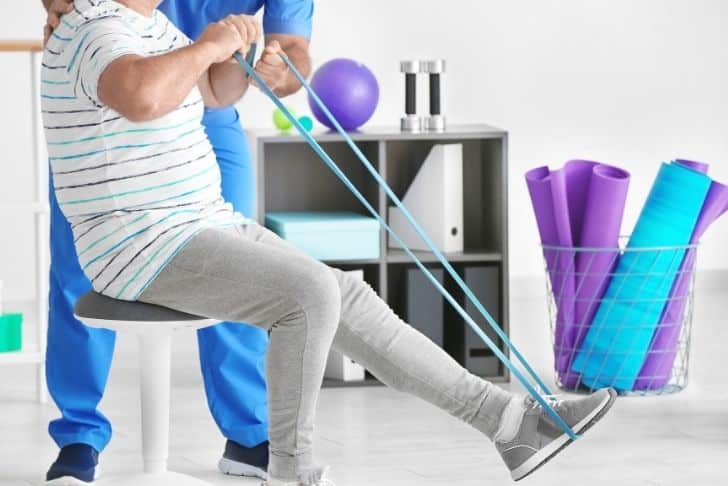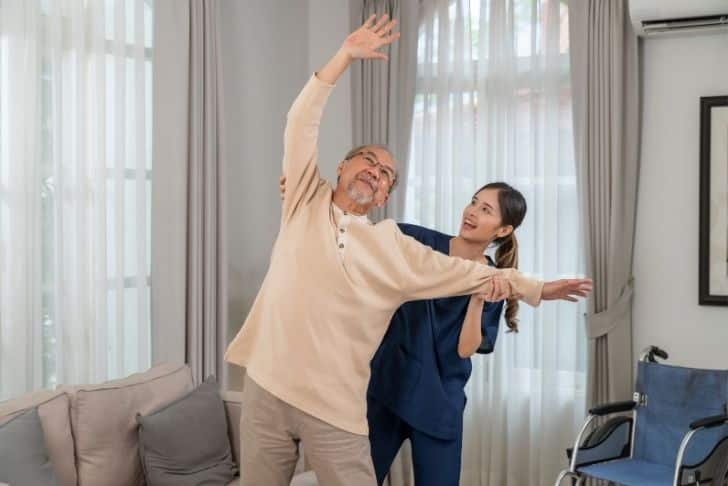In the spirit of fostering an active and healthy lifestyle as we age, “Innovative Core Strengthening Techniques for the Elderly – A Harvard Health Perspective” provides the elderly with some of the most effective core strengthening exercises to promote balance and stability. The article explains the importance of strengthening these core muscles that make up much of our trunk, crucial for supporting our lower back and helping us to stand, lift, bend, and maintain balance. It guides you through recommended techniques such as bridges, planks, and opposite arm and leg raises, highlighting their benefits, providing suggestions for safe practice, and encouraging consistent daily strengthening for optimal results. So gear up, it’s time to prioritize your health and give your core muscles the attention they deserve!
Understanding Core Strength and Its Importance for the Elderly
A fit and healthy body often relies on the strength and flexibility we maintain. One of the key components of this fitness is core strength. You might consider your core as the sturdy central link in a chain that connects your upper and lower body. Whether you’re mowing the lawn or lifting a bag of groceries, the necessary motions either originate from your core, or move through it. It’s a complex series of muscles that extend well beyond your abs and includes everything except your arms and legs.
Detailed Explanation of Core Strength
Core strength refers to the prowess of your back, chest, hips, and abdomen. These combined muscle groups provide stability for your body, allowing for balance during the multitude of physical activities and tasks you perform daily. Core strength, while vital for athletes, is equally crucial for the healthy aging and physical stability of the elderly.
Benefits of Core Strengthening Exercises for Elderly
As we age, our core muscles naturally weaken which can lead to poor balance and stability, and an increased risk of falls. However, strengthening these muscles can help to improve posture, promote better balance, and reduce the risk of injuries from falls. It can also alleviate back pain and make daily chores, such as lifting and bending, easier to manage.
Role of Core Strength in Maintaining Balance and Stability
Your core acts as a sturdy central link in a chain, connecting your upper and lower body. Almost all your movements are powered, at least in part, by your core. Maintaining a robust core improves your balance and stability, making it much less likely that you’ll fall or injure yourself.
Understanding Core Muscles
Going deeper into understanding the core, it’s essential to familiarize yourself with the group of muscles that comprise it.
Explanation of Muscles Considered Part of the ‘Core’
Generally speaking, the core starts at the lower rib cage and extends to the buttocks. Core muscles in the abdomen include the rectus abdominis muscles in the front; the external and internal obliques on the sides; and a broad, flat girdle in front called the transversus abdominis. Your back muscles, the erector spinae, help you stand upright and play a significant role in your core as well.
Role of Each Core Muscle in Body Function
Each subset of these core muscles plays a unique role in supporting your body. The abdominal muscles support the trunk, allow movement, and provide protection to your organs. The obliques help you twist, whereas the transversus abdominis contracts to increase intra-abdominal pressure. Lastly, your erector spinae help to extend and rotate the back.
How Core Muscles Interrelate with One Another and the Rest of the Body
Each of these muscles is used in harmony with one another to support your body and enable almost every physical activity. Whether it’s bending down to pick something up or walking up the stairs, your core muscles make it happen safely.
Potential Risks and Hazards of Traditional Core Exercises for Elderly
While core exercises are important, some traditional methods may not be best for the elderly population due to potential risks.
Explanation of Why Sit-ups and Crunches May be Dangerous for Elderly
Traditional core exercises like sit-ups and crunches expose the elderly to potential hazards and are not as effective as once believed. They strengthen only a few muscles and pose risks for older adults, primarily because of the strong pull on the neck.
How Traditional Core Exercises Can Lead to Imbalances and Pain
Exercises like sit-ups primarily train the hip flexor muscles, not the core. Overexerting these muscles can lead to imbalances, pulling on the lower back and contributing to back pain.
Other Potential Risks of Traditional Core Exercises for Elderly
Traditional core exercises could also potentially lead to muscle strains, hernias, and other injuries if not performed correctly or if one attempts to do too much too soon.

Safe and Effective Core Strengthening Techniques for Elderly
With the potential risks of traditional exercises in mind, it’s important to put focus on safe and effective core strengthening exercises for the elderly.
Introduction to Innovative Core Strengthening Exercises
Elderly individuals can benefit greatly from innovative core exercises that work multiple muscle groups at once, rather than just isolated muscles.
Benefits of Multi-Muscle Exercises Over Single Muscle Ones
Doing multi-muscle exercises are more beneficial because they mimic natural movements, such as lifting or climbing, and are therefore more functional. They help to improve your overall core stability.
Explanation of the Recommended Exercises: Bridges, Planks and Opposite Arm and Leg Raise
For older adults, the exercises recommended include bridges, planks, and opposite arm and leg raises. Bridges enable the creation of rigidity from the rib cage to the pelvis. Planks create contractions of the core, arm, and shoulder muscles as you stay in a push-up position. Opposite arm and leg raises stretch out the opposite arm and leg, contracting your core and the muscles in another arm and leg, providing support in the process.
Guidelines for Performing Bridge Exercise
Step-by-step Instructions for Performing Bridges
To perform a bridge properly, begin by lying on your back with your knees bent and feet flat on the floor, hip-width apart, and with arms by your side. Then, tighten your buttocks and lift your hips off the floor until they form a straight line with your hips and shoulders. Hold this position before returning to the starting position, and then repeat the exercise 10 times.
Muscles Targeted in the Bridge Exercise
The bridge exercise effectively works the gluteal muscles in your buttocks and your abdominal muscles, promoting strength and stability.
Tips to Ensure Safe and Effective Bridge Exercise Performance
The quality of movement here is key. Focus on slowly lifting your hips, and avoid letting your lower back sag or your hips twist during the up and down movement.
Guidelines for Performing Plank Exercise
Step-by-step Instructions for Performing Planks
For a plank, start on your hands and knees. Tighten your abdominal muscles and lower your upper body onto your forearms. The alignment should be such that your shoulders are directly over your elbows, with your feet in the air behind you. Your back should remain straight, and you should aim to make your body as much like a ‘plank’ as possible. Follow this with a hold, return to the starting position and repeat 10 times.
Muscles Targeted in the Plank Exercise
Plank exercises primarily target the muscles in your abdominals, shoulders, and arms.
Tips to Ensure Safe and Effective Plank Exercise Performance
It’s crucial that your back stays in a straight line throughout the exercise to avoid straining.

Guidelines for Performing Opposite Arm and Leg Raises
Step-by-step Instructions for Performing Opposite Arm and Leg Raises
Begin on all fours, with your head and spine in a neutral position. Extend your left leg off the floor behind you while simultaneously reaching out with your right arm. Try to bring them to be parallel to the floor without overxtending, hold the position, then return to the starting position. Repeat this sequence with your right leg and left arm and repeat on both sides 10 times.
Muscles Targeted in the Opposite Arm and Leg Raise Exercise
Opposite Arm and Leg Raises overall work your core, but also have the bonus of toning your arms and legs, given the lifted stance.
Tips to Ensure Safe and Effective Opposite Arm and Leg Raise Exercise Performance
It’s essential to keep movements slow and controlled throughout this exercise. Hastily throwing your arm and leg out can lead to losing your balance or straining your muscles.
Starting a Core Strengthening Program
As an elderly individual, if you are starting a core strengthening program, there are a few things to remember.
Recommendations for Starting Slow and Increasing Gradually
Start slowly, focusing on quality over quantity, and gradually increase the number of repetitions as your strength improves.
Guidelines for Daily Workout and Recovery
While other muscle groups require rest days, core exercises can be performed daily as it should always be working.
Effective Warm-up and Cool-down Exercises for Core Workout
It would help if you always warmed up before starting your workout to get your blood flowing. Such a routine could include arm movements or marching in place. After your workout, remember to cool down and stretch your muscles to aid recovery. This is especially important for muscles such as the hip flexors and hamstrings.
Maintaining Balance: Strength and Flexibility
Importance of Maintaining Balance Between Strength and Flexibility
While building and maintaining core strength is important, it’s equally essential to develop and sustain flexibility in the surrounding muscles.
Need for Flexible Muscles Surrounding the Core
Having flexibility helps muscles to lengthen and move, reducing the risk of injury. Additionally, a combination of strength and flexibility helps to keep the body balanced and reduces the chance of falling.
Suggested Stretching Exercises for Hip Flexors and Hamstrings
Stretching exercises, especially for the hip flexors in front of your pelvis and the hamstrings at the back of your thighs, are essential. These specific stretches help maintain flexibility in key areas, allowing for efficient movement and balance.
Harvard Health Perspectives and Recommendations
Summary of Harvard Health Insights on Core Strength for the Elderly
The perspectives from Harvard Health on core strength for the elderly emphasize the importance of regular exercise and maintaining a balanced body. The suggested workouts that engage multiple muscle groups, are crucial, given they improve overall core stability, making the body function more efficiently.
Recommended Resources for Additional Information
Harvard Health offers various resources on core exercises and strength training. To further enrich your knowledge of core strength and its importance, reading the Harvard Special Health Report on Core Exercises can be beneficial.
Final Words on the Importance of Core Strength in Overall Health for the Elderly
In conclusion, core strength is a vital component of health, especially as we age. Regular, safe and effective core exercises not only help prevent injuries and falls but also improve the quality of life. So, take the time to build and maintain those core muscles. It’s an investment in yourself and your health which would definitely pay off in time.

